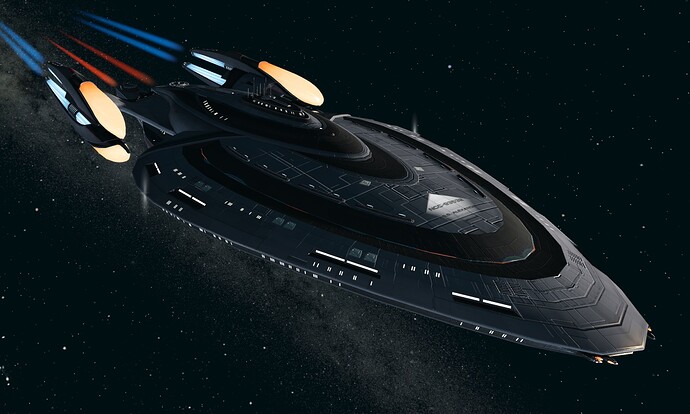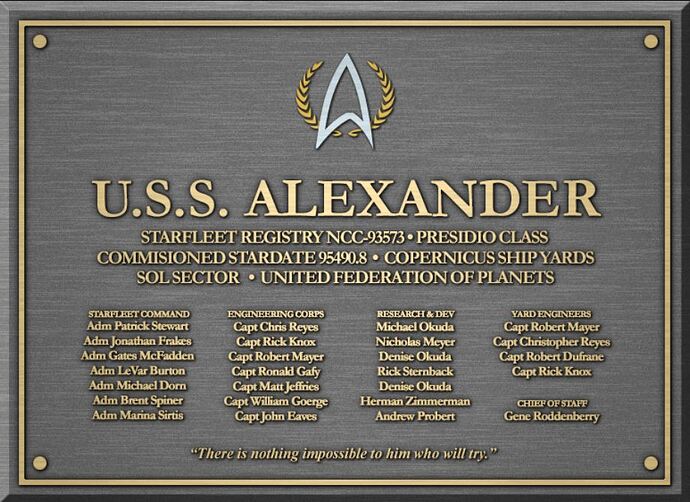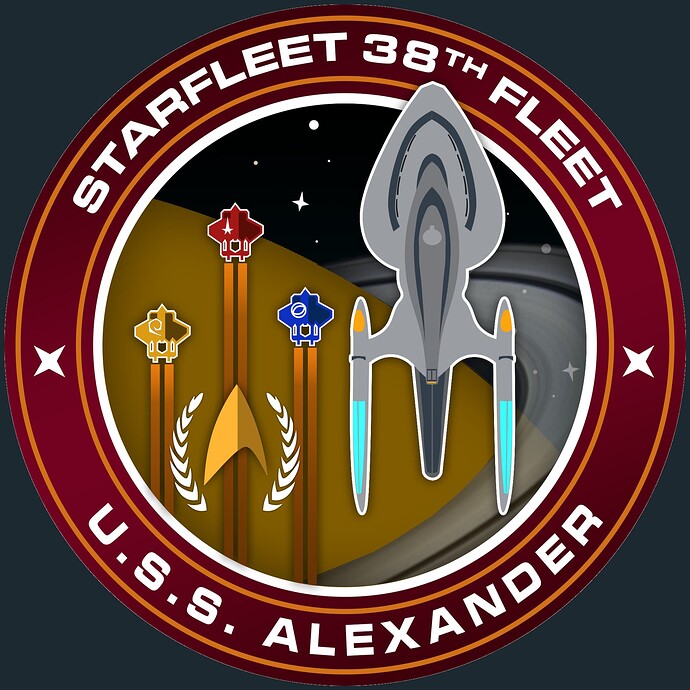U.S.S. Alexander
| USS Alexander | |
|---|---|
|
Class: Registry: Owner: Operator: Status: |
Presidio Class NCC-93532 United Federation of Planets Starfleet In Service |
The USS Alexander is a Tactical Command Battlecruiser Amalgamation in the service of the United Federation of Planets 38th Fleet Argo. Utilizing the base of a Presidio Class Battlecruiser, the USS Alexander encompasses the strengths and benefits of all of its class variants. Within the Frame and Profile of the Presidio Class Tactical Variant, the USS Alexander is equipped with the Engineering and Warp Nacelles of a Concord Class Engineering Variant, as well as the Deflector and Communication Arrays of a Geneva Class Science Variant. Capitalizing on the advancements in modern starship design, Starfleet Engineering Corps hoped to merge the three class variants into this ‘legacy variant’ prototype.
History of the Ship
The Presidio class was designed by the Starfleet Corps of Engineers in 2410 and launched in the same year. The development project was a cooperative effort between the Alpha Quadrant Alliance members, which saw the production of a total of nine ship classes, three per member state. One class of each faction was geared towards engineering, tactical and science. The Presidio-class command battlecruiser was geared towards tactical, the Concord-class command battlecruiser was geared towards engineering, and the Geneva-class command battlecruiser was geared towards science.
The Command Battlecruisers entered the Galactic Stage during the Delta-Rising Campaign in the joint efforts against the Undine, Voth, and Vaadwaur. At the start of the Iconian War, the prototype USS Presidio was one of the few ships to survive the initial attack and managed to maintain its position at Drozana Station. The USS Bern (Geneva Class) was instrumental in preventing Solanae forces from breaching out from their pocket dimension. USS Keller and USS Nelson (Both Geneva Class) was also present and recoverable from the Khitomer Alliance’s offensive against the Herald Dyson Sphere.
Because of the Stability and Power of these Battlecruisers, they were initially used as Command Flagships for Vice-Admiral or Higher, but have managed to spread down the ranks as more ships enter the fleet. Following the Hur’q Conflict, several Command Battlecruisers saw general refits with up-to-date tactical and engineering components, as well as more advanced sensors to keep up with newer ships of the line.
History of the Name
Many of Earths historical figures bore the name Alexander. From notable figures such as the Macedonia Conquer Alexander the Great, American Revolutionary Alexander Hamilton, Inventor Alexander Graham Bell, and various other Pope/King/Emperors of ancient history of the same name. Of note, there was three pre-space vessels, and three post federation vessels to bear the name Alexander:
| YEAR | NAME | REGISTRY | CLASS |
|---|---|---|---|
| 1916 | USS Alexander (J. Luke) | DER-557 | Buckley-Class Destroyer Escort |
| 1937 | USS Alexander (Hamilton) | WPG-34 | Treasury-Class Coast Guard Cutter |
| 1962 | USS Alexander (Hamilton) | SSBN-617 | Lafayette-Class Ballistic Missile Submarine |
| 2259 | USS Alexander (The Great) | NCC-551 | Saladin-Class Destroyer |
| 2269 | USS Alexander (The Great) | NCC-59611 | Constitution-Class Cruiser |
| 2421 | USS Alexander (The Great) | NCC-93532 | Presidio-Class Command Battlecruiser |
Technical Data
Standard Armament and Capabilities
| Specifications | |
|---|---|
|
Length: Beam: Draft: Mass: |
1032 m 375 m 160 m 8,500,000 mt |
|
Decks: Crew: Capacity.: |
32 750 4,000 |
|
Avg. Cruise: Max Cruise: Maximum Speed: |
Warp 8.25 Trans Warp 13 (2 hr) Trans Warp 28 (30 min) |
|
Standard Armaments: |
(x10) Mark XV Advanced Phaser Arrays (x02) Mark XV Wide-Angled Heavy Beam Banks (x04) Mark XV Wide-Angled Torpedo Launcher (x01) Mark XIV Omni-Directional Kinetic Cutting Beam Port/Starboard Broadside Emitter Arrays* |
|
Standard Defenses: |
Enhanced Neutronium Alloy Hull Plating Modified Adaptive Harmonic Shield Array Graviton Shield Emitter |
|
Auxiliary Craft: |
01x Captain's Yacht 06x Yellowstone Class Runabout 12x Type-8 Shuttlecraft 21x Peregrine Attack Fighters |
|
Deployable Platforms |
Defence Platform Secondary Shield Platform Tetryon Net Platform Barrier Field Generator Repair Platform |
Energy and Propulsion Systems
Equipped with a State-of-the-Art Mycelial Harmonic Matter-Antimatter Warp Core and, The USS Alexander is capable of generating the massive amount of power the ship demands. Experimental Systems aboard allow the ship to generate a Chroniton Integrated Quantum Slipstream Drive (Estimated Transwarp Factor of 28+) while a stand-alone Transwarp Computer System allows the ship to maintain said slipstream for longer durations of time. The Mycelial Wave-Impulse Engines gets the ship too and from its destination much quicker than one would expect a ship of its size.
Science and Sensor Systems
A Non-Baryonic Matter Deflector is installed on the front of the star-drive section. This array creates localized gravitational phenomenon that subtly distort space both within the warp field and at impulse speeds. This allows it to act both as an additional focus for the deflector output and as a measure of last resort against incoming torpedoes. A High-Energy Communications Network installed on the top section of the saucer increases scan intensity, as well as aiding in maintaining remote commands for drone operated craft, enhanced networking allowing for better communications in high-interference sections of space, as well as enhanced target locks.
Tactical and Defensive Systems
The USS Alexander is equipped with a Prolonged Engagement Power Dynamo Capacitor, which passively capture energy from the routine mechanical operations of combat, and convert it into useful electricity that increases your ship’s Subsystem Power levels. As the skirmish endures, the excess power level grows until the capacitors are filled. At any time, the Console can be activated to temporarily double the accumulated power or restore disabled systems.
She is equipped with 10 Advanced Phaser Arrays, 4 Wide-Angle Torpedo Launchers (2 Fore and 2 Aft), and Fore Facing Phaser Quad Cannons and a Modified Omni-Directional Cutting Beam. The ship is also outfitted with Broadside Emitter Arrays, which allows the ship to unleash a torrent of cannon fire from the sides of the ship. With a Quantum Field Focus Controller installed with the Deflector Dish, the ship is able to generate a Powerful Quantum Field Focused Phaser Beam using Auxiliary Power.
The ship is protected by an experimental modified shield grid which uses complex adaptive algorithms to handle a much noisier, dissonant shield harmonic than usual. As the field’s resting state is significantly less ordered than a typical field, it is far more resistant to disruption by enemy weapons fire. Further, its castoff energy causes destructive interference in enemy shield systems, weakening their ability to resist damage more and more as the amount of energy fed to the system increases.
A secondary Graviton Shield Grid can also be activated to protect the ship from gravimetric waves and kinetic impacts (such as interstellar debris, or kinetic projectiles) by projecting a reverse-tractor beam pulse through the shield generators to ‘reflect’ oncoming obstacles.
Per the Captains Request, the Alexander also maintains a stockpiled ordinance of Quantum Warheads, EMP Probes, Nadeon Detonators, Ionized Gas Sensors, Isometric Charges, and Spatial Charge Launchers that can be swapped out as the need arises.
Auxiliary Craft and Deployable Platforms
Decks 16 through 18 along the connective section between the Saucer and Stardrive is a completely dedicated Flight Deck, capable of housing over 20 small craft (Type 8 Shuttles and Peregrine Fighters) for Strike Wing Deployment, as well as Docking and Cargo Delivery. Deck 6 Houses the ships complement of larger/long range shuttlecraft (Yellowstone Runabout) whereas Deck 8 houses Diplomatic Transports, and the Captains Personal Shuttlecraft (Captains Yacht).
Along with various Cargo Space, the Command Battlecruisers come equipped with dedicated platform deployment bays for various probes and defensive platforms. Two Stationary Weapons Platforms can be launched which will fire beam arrays and continuously deploy mines in the area. A Stationary Tachyon Pulse Platform can be launched, which will drain the shields of enemy ships that come too close. A Shield Repair Platform can be launched, which will follow with the ship while under power and restore or bolster the shields of allied ships within range. Also a Repair Drone Platform can be launched which will replicate miniature work-bee drones to repair damage to the ship and its allies as needed.
The Alexander can also deploy a Barrier Field Generator, which will create a fixed force field between itself and a target creating a physical cover shield, however the barrier can be destroyed by weapons fire, and it still can provide an excellent deterrent and defensive measure. Each of these deployable platforms are programmed to ensure their energy signature is masked, so they are difficult for enemies to locate or target. The Repair Platform itself will also mask the energy output of nearby friendly starships it is working on, making them more difficult for enemies to detect.
Presidio Class Master Systems Display
Personnel
Commanding Officer
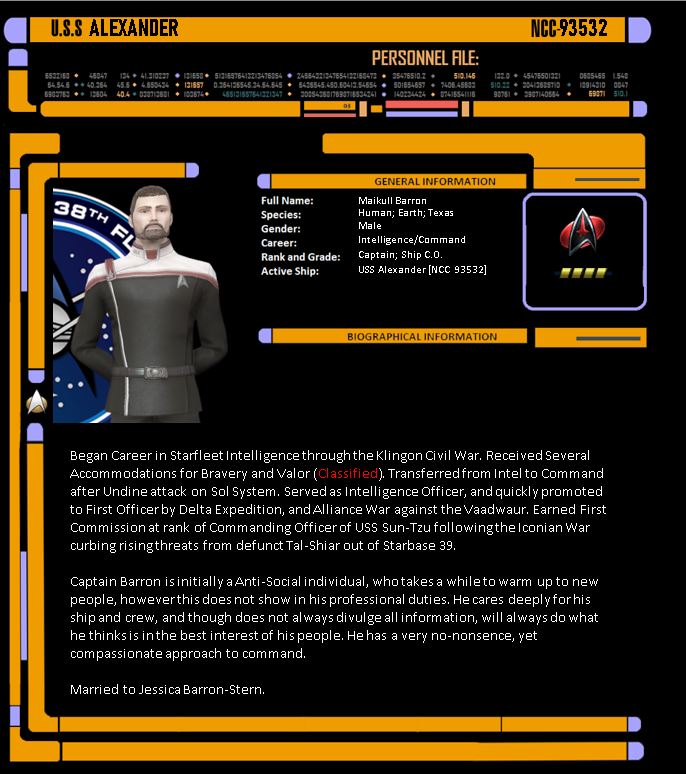
Executive Officer

Chief Operations Officer
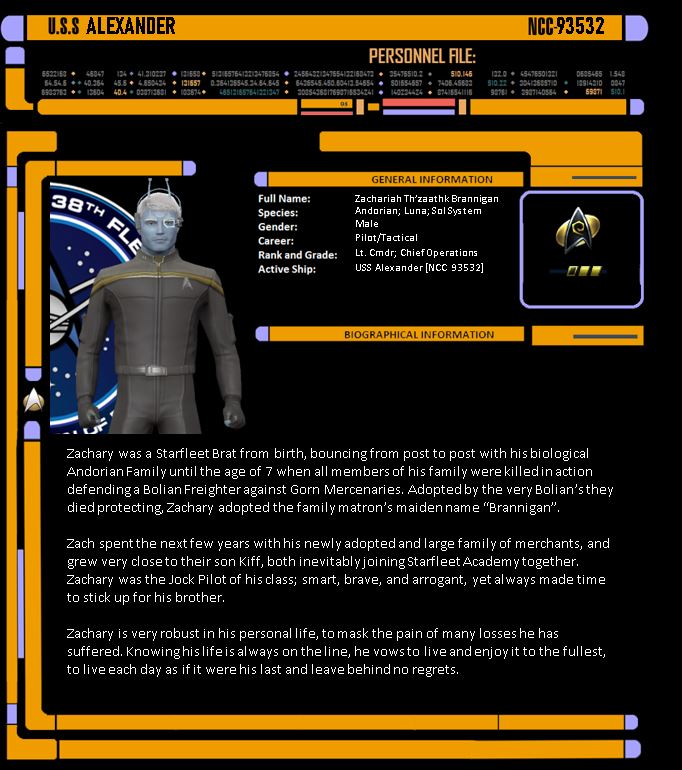
Chief Tactical/Security Officer
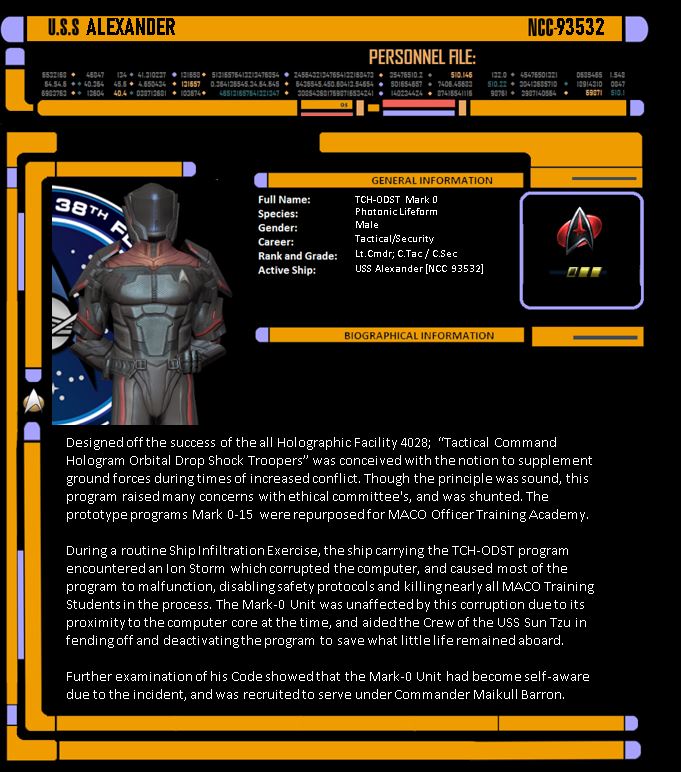
Chief Medical Officer

Chief Science Officer

Chief Engineering Officer
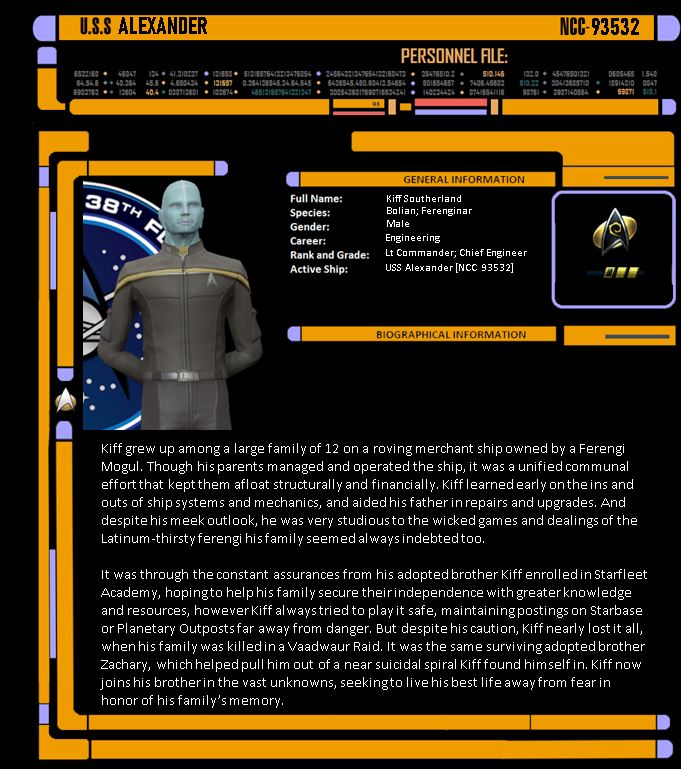
Intel Liason Officer
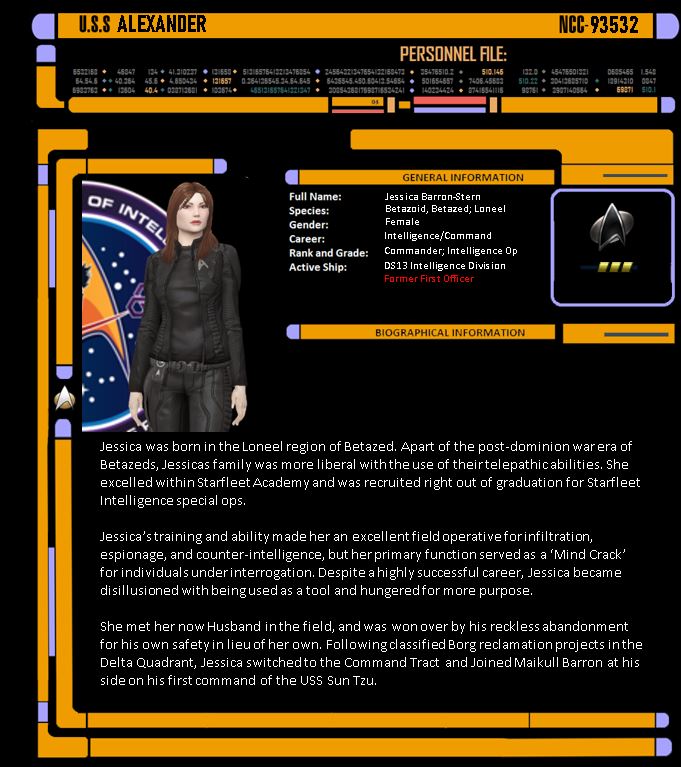
Service Records/Reports:
- 98848.3 -COMMS: Capt. Barron: Reassignment
- 98851.5 -AAR: Hostage Situation
- 98853.1 -AAR: Denovora Defence
- 98873.4 -AAR: d2483 System Skirmish
- 98875.2 -AAR: d2483 System Skirmish #2
- 98890.1 -AAR: Cutting the Kilur Cord
- 98892.8 -AAR: Driven out of Droni
- 98900.9 -AAR: Retribution #1
- 98901.0 -AAR: Retribution #2
- 98892.9 -AAR: Reflection Rampart
- 98904.1 -AAR: King of the Hill
- 99117.9 -Episode: Dreamscape
- 99155.9 -AAR: Road to Kacam
- 99246.5 - STARSHIP INSPECTION
- 99227.1 - AAR: Operation Roadblock
- 99242.9 - Temporary Assignment to Star Fleet Command
- 99413.7 - Released back in service to 38th Fleet
- 99415.6 - COMMS: XO Reassignment/Vacancy
- 99679.5 - COMMS: Command Org. Changes
OOC Ship Build
References
- Ships Plaque: Source Template made by FuryofaSeraph, Custom Redesign by S.J.Brex
- Ship MSD: Command Battlecruiser MSD found on 26thFleet.enjin.com [USS Mikasa] ((Modified to Fit Ship Name/Registry))
- Ship Data Found: [sto.fandom.com] [memory-alpha.fandom.com] [https://memory-beta.fandom.com/]
- Specific Ship Badge Created by @LobsterEater (Much appreciated!)
